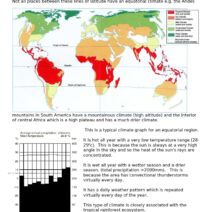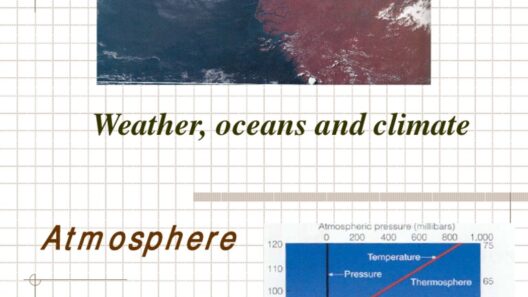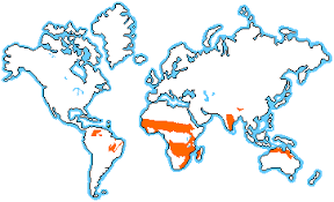Turkey’s climate is an intricate tapestry woven from a multitude of weather patterns, presenting a unique fusion of environmental characteristics that reflect its geographical diversity. Nestled at the crossroads of Europe and Asia, this nation experiences a medley of climatic zones, which can be broadly categorized into several distinct regions. Understanding Turkey’s climate requires an examination of the confluence of its topography, latitude, and proximity to various bodies of water.
One of the most prominent climatic regions in Turkey is the Mediterranean climate, predominantly found along the western and southern coasts. This zone is characterized by hot, dry summers and mild, wet winters. The majority of rainfall occurs between November and March, while the summer months see minimal precipitation. This climatic pattern encourages biodiversity and has significant implications for agriculture, particularly the cultivation of olives, citrus fruits, and grapes, which thrive in warm, sunny environments. The warm seas surrounding Turkey amplify the Mediterranean influence, providing a thermal buffer that moderates extreme temperature fluctuations.
In stark contrast, the interior regions of Turkey are dominated by a continental climate, exemplified by hot summers and cold, harsh winters. This climate is especially prevalent in the Central Anatolian plateau, where the elevation contributes to more extreme temperature variations. During the summer, temperatures can soar above 35°C (95°F), while in winter, they can plummet to -20°C (-4°F) or lower. The scarcity of moisture leads to arid conditions, which pose challenges for agriculture, heavily relying on irrigation for sustainable crop production. The flora and fauna of this region are hardy, adapted to thrive under stress, with the steppe vegetation predominating.
Moving towards the northeastern parts of Turkey, the climate transitions into a humid continental climate, marked by significantly more precipitation compared to the central areas. The Black Sea region, in particular, is characterized by lush greenery and a temperate climate, shaped by moist winds originating from the Black Sea. Here, the summer months are warm, while winters are cold yet milder than the central plateau. The rich biodiversity in this area is remarkable, featuring dense forests and a variety of wildlife, making it one of the richest ecological zones in Turkey.
Another fascinating aspect of Turkey’s climate is the influence of the mountains, which act as natural barriers that affect local weather patterns and microclimates. The Taurus and Zagros mountain ranges create diverse climatic conditions across short distances. For example, while the coastal area may bask in Mediterranean warmth, the mountain slopes can receive heavy snowfall and provide cooler temperatures, enabling different ecosystems to coexist. Such vertical climatic diversity is crucial for local agriculture, as it allows for the cultivation of various crops adapted to specific altitudes.
In recent years, climate change has begun to exert its influence on Turkey’s weather, bringing about erratic patterns and unprecedented climatic events. Droughts have become more frequent, particularly in the central and southeastern regions, posing severe risks to water availability and agricultural productivity. Conversely, other parts of the country have witnessed increased rainfall and flash flooding, leading to soil erosion and damaging infrastructure. These stark contrasts illustrate the vulnerability of Turkey’s climate and the imperative for adaptive strategies in both urban planning and agricultural practices.
Given Turkey’s status as one of the world’s leading agricultural producers, with a mix of traditional practices and modern techniques, climate variability poses challenges and opportunities alike. Sustainable agricultural practices are more vital than ever, fostering resilience against the unpredictable climatic shifts. Organic farming, crop rotation, and the use of drought-resistant crops are methods gaining traction to mitigate some impacts of climate change.
Tourism in Turkey is another sector significantly affected by climatic conditions. Coastal tourism thrives in the summer months, thanks to the Mediterranean climate, while winter tourism in the highlands is contingent on sufficient snowfall. Climate variability can lead to fluctuations in tourist numbers, as seasons may become less predictable, impacting local economies. As travelers increasingly seek eco-friendly and sustainable options, adapting tourism infrastructure to weather changes becomes essential.
Moreover, urban areas like Istanbul experience a unique climate characterized by urban heat islands, where built environments absorb and re-radiate heat. Such phenomena may exacerbate summertime heat extremes, complicating the urban dwellers’ living conditions. As cities expand and populations grow, the pressures on urban planning and public health systems intensify, necessitating proactive climate strategies to enhance urban resilience.
Turkey’s climate is a multifaceted subject, embodying the complexity and richness of its geographical features. From the Mediterranean warmth of the coastal regions to the harsh continental interior, the contrasting climates reflect a broader narrative about weather patterns and climate change. As understanding deepens, it becomes clear that Turkey stands at a critical juncture, grappling with both opportunities and challenges posed by its unique climatic tapestry. Embracing sustainable practices across various sectors is pivotal in ensuring that Turkey can navigate the complexities of its climate while preserving its rich biodiversity for future generations.








